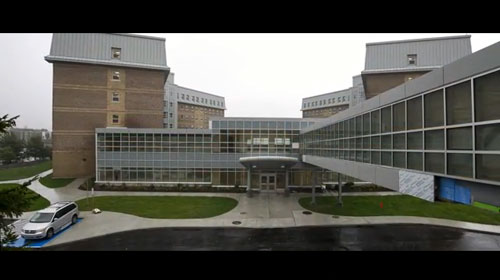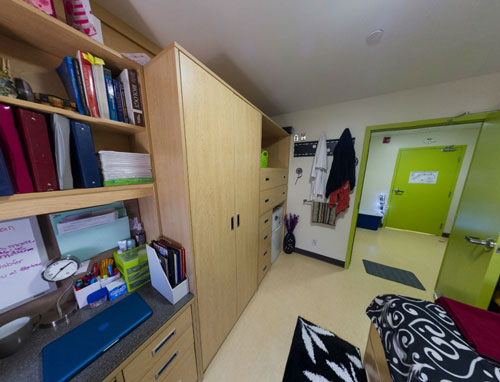Building a distinguished university isn’t easy. It takes time. And funding. And considerable planning and hard work. However, the proverbial foundations have already been laid for Memorial’s future, and many upgrades and expansions are well underway. As the university's student body and faculties grow and change, we are taking the necessary actions to meet the needs of this thriving academic community.
This past year much of the construction and planning was completed for many infrastructure additions and upgrades, including new residences at both St. John’s and Grenfell campuses, new labs at Grenfell, the Craig L. Dobbin Genetics Research Centre and Faculty of Medicine expansion, plus improvement of the Department of Ocean Sciences’ facilities and construction of the Centre for Arctic Resource Development and the Suncor Energy Offshore Research and Development Centre. Early planning is also underway for new core sciences infrastructure.
As the university and its academic offering grows, so does the interest of prospective students. The demand for increased availability of on-campus housing was a pressing issue and, as a result, new residences were built for our St. John’s and Grenfell campuses. To match the capacity of these new modern facilities, our previously existing residences also underwent transformations to enhance the capabilities of the facilities, an improvement required to keep up-to-date with current day student life. Both Grenfell and the west tower of the St. John’s residence welcomed their first residents this year, while the east tower in St. John’s is set to open in January 2014.
After careful deliberation, Memorial University purchased the former Battery Hotel in March 2013. The building and operations will be cost-neutral to the university: a number of Memorial’s public engagement support units located around the St. John's campus will move to the new property, freeing up space for units currently renting off campus.
Activities at the building will support Memorial’s public engagement work by providing a university presence in downtown St. John’s. Provincial participation and involvement will also be facilitated through technology and programming, offering opportunities to individuals and organizations across Newfoundland and Labrador. In addition, the building will include dedicated residence space for graduate students, planned in consultation with the Graduate Students’ Union. Planning has already begun to revitalize, repurpose and breathe new life into this landmark.

Thanks to funding provided by Suncor Energy and the Research and Development Corporation of Newfoundland and Labrador (RDC), the S.J. Carew Building, home of the Faculty of Engineering and Applied Science, is expanding. The new facility, known as the Suncor Energy Offshore Research and Development Centre, is a 1,090-square metre facility designed to accommodate and promote our rapidly growing ocean technology and offshore petroleum research programs. Aside from providing much needed integrated space for innovative research and industry collaborations, the centre will allow us to increase our contract research related to ocean/offshore engineering and to train highly qualified students for these industries. The facility will grow the Faculty of Engineering and Applied Science research and development activities by an estimated $6 to $8 million per year over the next five years and employ about 100 full-time equivalent researchers. This expansion will be key in fostering a greater collaboration synergy among faculty, graduate students and industry partners.
The vast, varied Arctic landscape holds a wealth of natural resources. It also presents a unique set of challenges. Ultra-low temperatures, 24-hour darkness lasting months at a time and extreme sea ice features such as icebergs and ice islands that can scour the seabed, all threaten production infrastructure. C-CORE, founded by Memorial in 1975 as the Centre for Cold Ocean Resources Engineering, recently added two floors to the Jack Clark Building to house its Centre for Arctic Resource Development (CARD), an industry-guided centre of excellence focused on medium- to long-term research to fill the gaps in the knowledge and technology that are currently barriers to development of Arctic oil and gas resources.
CARD’s three research foci (ice mechanics, ice management and station-keeping in ice) all involve large-scale physical and mathematical modelling. The 1,260-square metre expansion provides new capacity to execute CARD’s ambitious research program. Designed to leverage existing research capacity, promote collaboration and foster a multidisciplinary approach to research, the facility’s advanced connectivity capabilities include gigabit Ethernet cables to process large datasets quickly, multi-screen cloud-conference rooms and large, open spaces equipped with information and audio-visual technology that allow researchers and students to better connect and collaborate with researchers both in-house and around the globe. It will also allow CARD to train a new generation of Arctic researchers and engineers anywhere in the world.

Next steps are now in motion for the development of new core sciences infrastructure thanks to significant funding provided by the provincial government. Designed to attract and retain faculty and students, this state-of-the-art core sciences facility will house high-end laboratories for the Faculty of Science and additional engineering space as part of the strategic initiative of doubling the size of the Faculty of Engineering and Applied Science. The facility will also supplement the university’s current capacity and allow for the revitalization of existing infrastructure. This contemporary and flexible space will promote inter- and multidisciplinary approaches to science, a key factor in not only maintaining our position as a leading top-quality, 21st-century teaching and learning environment, but also in ushering in deeper study into a world characterized by rapid change, uncertainty and increasing interconnectedness.
The facilities of the Department of Ocean Sciences are quite remarkable. What started in 1967 as the Marine Sciences Research Laboratory, in a single iconic round building, has since grown into a grouping of top-notch facilities and personnel in marine research that have become Memorial’s Department of Ocean Sciences. Over the years scientists from all parts of the globe have relocated to Newfoundland and Labrador to take advantage of these state-of-the-art facilities and research programs. The capabilities to study high latitude, cold ocean organisms and processes, many of which are not available anywhere else in the world, makes this facility unparalleled in the ocean sciences research sector.
However, research space is still limited. In an attempt to attract and retain the finest new students and faculty members, the department undertook enhancements to increase the facilities’ capabilities, including adding a stable source of seawater, space to house new imaging equipment, a new Level 3 containment facility and more laboratories.
As a result, researchers now get access to unrivalled specialized equipment, our students receive cutting-edge education and the community benefits from the best minds working together to answer significant ocean-related questions.

Grenfell Campus is looking up. Way up. A new observatory, that houses Atlantic Canada’s largest astronomical telescope is among the long list of recent upgrades all housed in the new Arts and Science Extension. Grenfell Campus was in need of new academic, research, computing and meeting spaces. To respond, the expansion was designed to benefit several disciplines such as chemistry, physics, earth sciences, biology and education. The extension, which also houses an Aboriginal student space, faculty and staff offices, as well as dedicated computer lab and study areas, will be a striking architectural feature of Grenfell Campus for years to come.

To meet our key goals of building research capacity, creating expertise in strategic sectors, developing new graduate programs, and attracting and retaining new students and highly qualified personnel at Grenfell Campus, a new facility was required. The state-of-the-art 500 square metre Environmental Research Facility, set to open in late autumn 2013, will house three inter-connected analytical research laboratories. The three labs will consist of a processing room for field samples, an extraction and low level analytical lab, and a high-end analytical facility complete with sensitive scientific instruments for studying soils, plants, air and water. This modern facility will offer faculty and students access to the most advanced research instruments in the industry and will be fully equipped with the very best computer and communications resources. This facility, along with the new faculty, programs and partnerships it will attract, will enable Memorial University to work collaboratively with provincial and federal organizations to develop and protect the environmental, forestry, and agricultural resources of the province.

Building a healthy tomorrow for the people of this province starts with building the right research and education facilities today. Together, the Government of Newfoundland and Labrador and the Canada Foundation for Innovation have funded a six-storey extension that will become the Faculty of Medicine’s new home and house the Craig L. Dobbin Genetics Research Centre and the Medical Education Centre.
The new genetics centre is named in honour of the late businessman Dr. Craig Dobbin, in recognition of a significant gift from his wife, Elaine Dobbin, that supports health research in the form of student bursaries, graduate student scholarships, two postdoctoral fellowships and a research fund in the Faculty of Medicine.
The genetics centre, which will include everything from patient care clinics to advanced research spaces, will enable the growth of leading genetic research activity, attract qualified specialists to the province and lead to the best possible health care. The Medical Education Centre will enable the growth of leading genetic research activity, attract qualified specialists to the province and increase the medical student class size from 60 students to more than 80, starting in the fall of 2013. This will mean more students from Newfoundland and Labrador will be educated here to become doctors to meet the health needs of the province. An advanced patient simulation centre, two large lecture theatres, standardized patient exam rooms, educational support units, and wet and dry laboratory research spaces are just some of the key features of this new 13,935-square metre building.
With help from the community and the province, this project demonstrates a collective commitment to enhancing health care for people throughout Newfoundland and Labrador.








